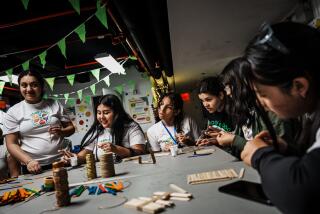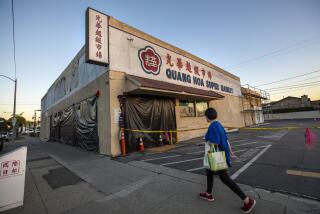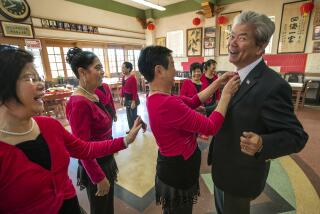Scouting the East
- Share via
U.S. and China relations have long stumbled over human rights, trade and arms reduction. Add to that list of differences, the Boy Scouts of America.
Hoping to someday end China’s decades-old ban on Scouting, a group of San Fernando and San Gabriel valley Scouts are heading eastward today to show educators in four of China’s largest cities what U.S. Scouts do, including such activities as Native American dances and flag salute ceremonies.
Scouting was banned by Chairman Mao Tse-tung after the Cultural Revolution of the 1960s and later under Chinese leader Deng Xiaoping. China decided instead to go with the Youth Pioneer Program, a Russian version of the Scouts with heavy emphasis on communist ideology.
Whether the visit by the California Boy Scouts will someday lead to an end to the ban is uncertain, but they hope to show the Chinese the benefits of Scouting.
Their trip beginning today follows three years of visits to the United States by Chinese educators and students who were so impressed with the Scouts that they created their own Boy Scout troop, based in the San Gabriel Valley and composed of Chinese youths visiting the United States on cultural exchange programs. The troop has about 160 Scouts and adult leaders.
Since 1994, Scout leaders in the San Gabriel Valley have been taking Chinese exchange students and their adult chaperons on camping trips to introduce them to youths their own age and to give them a taste of American life.
“Trips like these are bringing us closer together in the world,” said JoAnn Mo of El Monte, a longtime Le Gore elementary schoolteacher and mother of an Eagle Scout. Mo hosted many of the visiting Chinese in years past and said they were keenly interested in Scouting, noting its emphasis on leadership, individual initiative and patriotism.
“Before, these children would only know what the state would tell them about America,” Mo said. “The Scouts have become a bridge between these kids.”
The California Boy Scouts’ tour of China, billed as a cultural and educational exchange, is being sponsored by a San Gabriel Valley-based consulting firm, SIAS Group Inc., and the China Education Commission and will include stops in Beijing, Shanghai, Zhengzhou and Xi’an. Seven Boy Scouts, 10 other Southern California students--from elementary school to college age--and 37 educators will tour Chinese schools and talk to officials about the U.S. educational system.
SIAS President Shawn Chen hopes the trip will familiarize the Scouts with Chinese culture so they will be able to recruit Chinese American members more effectively here. Even as the Asian population in Southern California steadily increases, Chinese Americans are sorely underrepresented in local Scout troops, Chen said.
“We have a vision to attract more Chinese members,” he said. “We will have Boy Scout leaders go to China and come back and do more outreach in the Asian community.”
Eagle Scout Brent Bladow of West Hills plans to do a little outreach while in China as well.
“I am going there to perform and to promote the Scouting program,” said Bladow, 21, a member of the elite Order of the Arrow--an honor camping group chosen by their peers on the basis of their Scouting skills and leadership abilities. Members of the order learn about American Indian culture, including traditional folklore, dress and dances. Bladow, who has performed in several Scout powwows in the area, will dance in China with two other members of the order, Canoga Park resident Jeremy Mo, 20, and Sean Weller, 16, of Panorama City.
Bladow said he had a difficult time packing his dancing regalia, which includes a headdress made of porcupine guard-hair and a pair of shoulder fans made of imitation eagle feathers.
“I think it would be really neat to have something like the Scouts in China,” Bladow said.
But Chen was a little more skeptical: “There are some other countries that have Boy Scouts, like Taiwan and countries in Europe. But China? It’s too hard to predict.”
More to Read
Sign up for Essential California
The most important California stories and recommendations in your inbox every morning.
You may occasionally receive promotional content from the Los Angeles Times.










